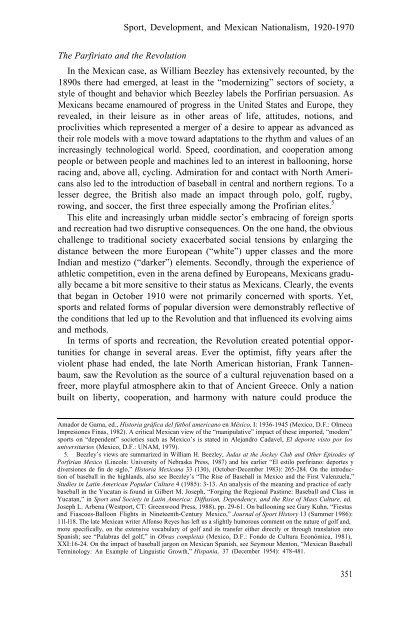Sport Development and Mexican Nationalism - LA84 Foundation
Sport Development and Mexican Nationalism - LA84 Foundation
Sport Development and Mexican Nationalism - LA84 Foundation
Create successful ePaper yourself
Turn your PDF publications into a flip-book with our unique Google optimized e-Paper software.
<strong>Sport</strong>, <strong>Development</strong>, <strong>and</strong> <strong>Mexican</strong> <strong>Nationalism</strong>, 1920-1970<br />
The Parfiriato <strong>and</strong> the Revolution<br />
In the <strong>Mexican</strong> case, as William Beezley has extensively recounted, by the<br />
1890s there had emerged, at least in the “modernizing” sectors of society, a<br />
style of thought <strong>and</strong> behavior which Beezley labels the Porfirian persuasion. As<br />
<strong>Mexican</strong>s became enamoured of progress in the United States <strong>and</strong> Europe, they<br />
revealed, in their leisure as in other areas of life, attitudes, notions, <strong>and</strong><br />
proclivities which represented a merger of a desire to appear as advanced as<br />
their role models with a move toward adaptations to the rhythm <strong>and</strong> values of an<br />
increasingly technological world. Speed, coordination, <strong>and</strong> cooperation among<br />
people or between people <strong>and</strong> machines led to an interest in ballooning, horse<br />
racing <strong>and</strong>, above all, cycling. Admiration for <strong>and</strong> contact with North Americans<br />
also led to the introduction of baseball in central <strong>and</strong> northern regions. To a<br />
lesser degree, the British also made an impact through polo, golf, rugby,<br />
rowing, <strong>and</strong> soccer, the first three especially among the Profirian elites. 5<br />
This elite <strong>and</strong> increasingly urban middle sector’s embracing of foreign sports<br />
<strong>and</strong> recreation had two disruptive consequences. On the one h<strong>and</strong>, the obvious<br />
challenge to traditional society exacerbated social tensions by enlarging the<br />
distance between the more European (“white”) upper classes <strong>and</strong> the more<br />
Indian <strong>and</strong> mestizo (“darker”) elements. Secondly, through the experience of<br />
athletic competition, even in the arena defined by Europeans, <strong>Mexican</strong>s gradually<br />
became a bit more sensitive to their status as <strong>Mexican</strong>s. Clearly, the events<br />
that began in October 1910 were not primarily concerned with sports. Yet,<br />
sports <strong>and</strong> related forms of popular diversion were demonstrably reflective of<br />
the conditions that led up to the Revolution <strong>and</strong> that influenced its evolving aims<br />
<strong>and</strong> methods.<br />
In terms of sports <strong>and</strong> recreation, the Revolution created potential opportunities<br />
for change in several areas. Ever the optimist, fifty years after the<br />
violent phase had ended, the late North American historian, Frank Tannenbaum,<br />
saw the Revolution as the source of a cultural rejuvenation based on a<br />
freer, more playful atmosphere akin to that of Ancient Greece. Only a nation<br />
built on liberty, cooperation, <strong>and</strong> harmony with nature could produce the<br />
Amador de Gama, ed., Historia gráfica del fútbol americano en México, I: 1936-1945 (Mexico, D.F.: Olmeca<br />
Impresiones Finas, 1982). A critical <strong>Mexican</strong> view of the “manipulative” impact of these imported, “modem”<br />
sports on “dependent” societies such as Mexico’s is stated in Alej<strong>and</strong>ro Cadavel, El deporte visto por los<br />
universitarios (Mexico, D.F.: UNAM, 1979).<br />
5. Beezley’s views are summarized in William H. Beezley, Judas at the Jockey Club <strong>and</strong> Other Episodes of<br />
Porfirian Mexico (Lincoln: University of Nebraska Press, 1987) <strong>and</strong> his earlier “El estilo porfiriano: deportes y<br />
diversiones de fin de siglo,” Historia <strong>Mexican</strong>a 33 (130), (October-December 1983): 265-284. On the introduction<br />
of baseball in the highl<strong>and</strong>s, also see Beezley’s “The Rise of Baseball in Mexico <strong>and</strong> the First Valenzuela,”<br />
Studies in Latin American Popular Culture 4 (1985): 3-13. An analysis of the meaning <strong>and</strong> practice of early<br />
baseball in the Yucatan is found in Gilbert M. Joseph, “Forging the Regional Pastime: Baseball <strong>and</strong> Class in<br />
Yucatan,” in <strong>Sport</strong> <strong>and</strong> Society in Latin America: Diffusion, Dependency, <strong>and</strong> the Rise of Mass Culture, ed.<br />
Joseph L. Arbena (Westport, CT: Greenwood Press, 1988), pp. 29-61. On ballooning see Gary Kuhn, “Fiestas<br />
<strong>and</strong> Fiascoes-Balloon Flights in Nineteenth-Century Mexico,” Journal of <strong>Sport</strong> History 13 (Summer 1986):<br />
11l-l18. The late <strong>Mexican</strong> writer Alfonso Reyes has left us a slightly humorous comment on the nature of golf <strong>and</strong>,<br />
more specifically, on the extensive vocabulary of golf <strong>and</strong> its transfer either directly or through translation into<br />
Spanish; see “Palabras del golf,” in Obras completas (Mexico, D.F.: Fondo de Cultura Económica, 1981),<br />
XXI:16-24. On the impact of baseball jargon on <strong>Mexican</strong> Spanish, see Seymour Menton, “<strong>Mexican</strong> Baseball<br />
Terminology: An Example of Linguistic Growth,” Hispania, 37 (December 1954): 478-481.<br />
351
















